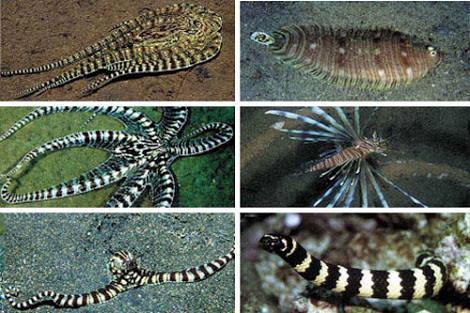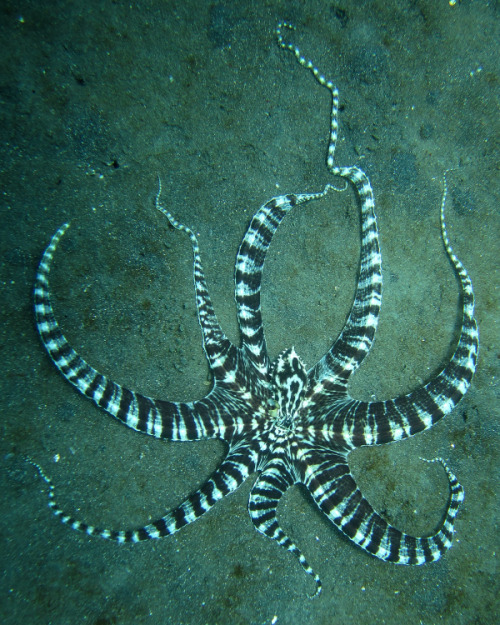Mystique of the sea: Mimic octopusRemember Mystique from X-Men who can impersonate anyone? Unlike he
Mystique of the sea: Mimic octopusRemember Mystique from X-Men who can impersonate anyone? Unlike her, the mimic octopus is not a character from a story book but an awesome creature with an amazing ability to ape a few marine creatures. The talent of the mimic octopus, belonging to class Cephalopoda (literal translation = head-foot) has surpassed any other living organism, and has fascinated the scientists since its discovery in 1998 from the estuarine waters of Sulawesi, Indonesia.The cephalopods appeared in the late Cambrian and around 438 million years ago, branched out into two subclasses: Nautiloidea consisting of ancient nautiloids with external shelled bodies, and Coleoidea consisting of modern day, soft-shelled organisms. The soft-shelled body of the modern day cephalopods, such as octopuses, squids, and cuttlefishes makes them vulnerable to predators but they have developed impressive abilities to avoid predation. They use an array of defensive mechanisms such as changing body color (camouflaging), changing shape and texture to blend with their surroundings, and sometimes discharging ink-black fluid into the water to escape their enemies. These molluscs are thought to be the most intelligent of invertebrates due to their large brains and well developed senses.The mimic octopus, Thaumoctopus mimicus also possesses these abilities but it takes mimicry to a whole new level. The soft-shelled, small body, (60 cms in length), with bold, brown and white striped skin coloring makes the mimic octopus an accessible target for predators who can easily approach the octopus in the shallow, muddy water. To evade its attackers, it not only changes color or shape but also mimics a variety of marine animals. Animals often use mimicry as a survival strategy. Some example include stick insects mimicking twigs or non-poisonous snakes mimicking poisonous ones; both cases help the animal to avoid predation.Although mimicry is quite common amongst octopuses, typically one species of octopus can mimic only a specific kind of marine species whereas a mimic octopus can imitate many different marine species. The mimic octopus has evolved an even more advanced type of strategic mimicry by mimicking different poisonous marine species depending on the local environment.When the mimic octopus is attacked by the highly territorial damselfishes the octopus splays its two striped tentacles on either side, hides the other six within the sand, changes its skin color to black and yellow stripes, and thus resembles the poisonous banded sea snake, a predator of the damselfishes. At times to avoid large predators, like sharks and barracudas, the octopus will mimic poisonous and unpalatable fishes such as the lionfish or flatfish. When the octopus imitates a lionfish, its brown-white striped tentacles spread out, flailing widely and trailing a little from its body, similar to the venomous striped fins of the lionfish. It impersonates the poisonous striped flatfish by pulling all the tentacles behind, moving in a swaying and gliding motion just like a flatfish along the sea floor.Besides these three species, mimic octopuses have also been reported to imitate jellyfish, stingrays, mantis shrimps, and sea anemones. This creature is highly intelligent and is able to sense which organism to imitate to evade its current possible predator, often shifting from one impersonation to another while on the move just like a pro. Since the mimic octopus lives in the vicinity of sharks and barracudas, both of whom consider this soft-shelled mollusc a tasty morsel, it needed to be an expert at impersonating creatures which these predators would naturally avoid to survive. Behavioural scientists are still studying this creature in order to understand how the complex mimicry that makes this species such a master of disguise evolved and whether or not there is any correlation between their mimicry and their high level of intelligence.–RBFurther information: http://bit.ly/1fxXtJwhttp://bit.ly/1eJq1Q7http://bit.ly/1GKJgBShttp://bit.ly/1NkbMvPhttp://bit.ly/1BT824ehttp://bit.ly/1HkX3Tehttp://bit.ly/1Gy9fKDImage: http://bit.ly/1wvvjpvhttp://bit.ly/1FFQT8AThe Indonesian Mimic Octopus: http://youtu.be/H8oQBYw6xxcReferences: Norman, M. D., J. Finn, and T. Tregenza. 2001. Dynamic mimicry in an Indo-Malayan octopus. Proceedings of the Royal Society of London B 268 (Sept. 7):1755 -- source link
#science#biology#ocean#mimic octopus#cephalopod#cephalopodweek#mimic#mimicry#mollusc#octopus#thaumoctopus mimicus#predator#predation#evolution

